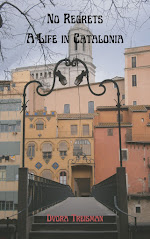I recently went to revisit the Drassanes, one of my favorite
buildings in Barcelona. So today I’ll be
cheating a little. That is to say,
instead of writing my own, I’m presenting to you what Robert Hughes has to say
about the Drassanes of Barcelona. He is
a great lover of Barcelona and probably doesn’t mind my promoting his favorite
city (and his excellent book).
“…The most vivid memories of any of the past métiers of
Barcelona are those of the sea, its maritime essence; and they are preserved in
the Drassanes, the ancient shipyards of the city that now house the Maritime
Museum – a place as remarkable for its building as for its contents. The site, at the bottom of the Ramblas, gives
a clear idea of how far Barcelona has filled in its own waterfront in the last
half millennium. When they were built in
the fourteenth century, the slipways that ran the finished galleys into the
harbor stood right on the water; today the Drassanes are landlocked, standing a
couple of hundred yards back from the water’s edge.
This is the most complete shipyard, and perhaps the most
stirring ancient industrial space of any kind, that has survived from the
Middle Ages: a masterpiece of civil engineering. The Barcelona shipyards were started in the
thirteenth century by Pere II (the Great), and finished (at least in their
essential outlines) by an architect named Arnau Ferré, working for Pere II’s son Pere III (the Ceremonious),
around 1378. In their time they were
known as the new shipyards, since they replaced the older and smaller ones the
Arabs had built on roughly the same site.
To build a large ship you need a large covered space, and that is what
the Drassanes afforded: a set of long parallel bays made of brick, their tiled
roofs carried o great diaphragm arches….
In these rigorously plain and imposing spaces, the biggest vessels in
the Mediterranean were built. A facsimile
of one of them, the capitana, or
flagship, in which Don Juan of Austria led the Christians to victory over the
Turks at Lepanto in 1571, occupies one entire bay, its high deck almost
scraping the roof, a sleek baroque war machine encrusted with gilt and red
lacquer, 195 feet long, displacing 237 tons, with fifty-eight oars as thick as
telegraph poles, each worked by ten slaves.” (






















Remarkable!
ReplyDelete